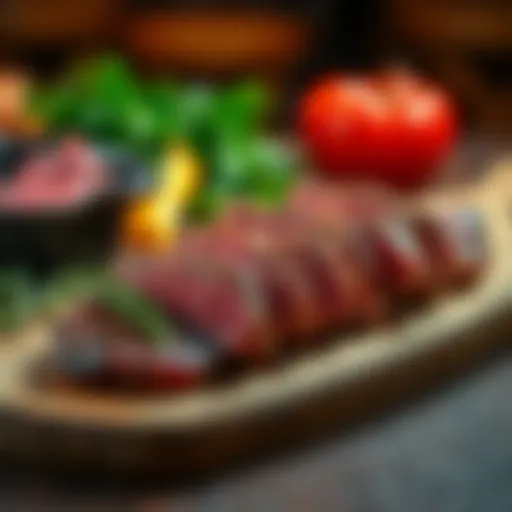Exploring Good Cheap Sake: Your Ultimate Guide


Intro
Sake, often called "nihonshu" in Japan, offers a wide array of flavors and aromas. Many people associate sake with premium brands that can be quite expensive. However, the world of affordable sake is both expansive and intriguing, providing numerous options that do not compromise on quality. Understanding good cheap sake requires us to look beyond the price tag.
In this article, we will explore the characteristics of sake, its production methods, and various budget-friendly options available to consumers. By examining definitions of quality and taste, we uncover how to appreciate sake without breaking the bank. This guide aims to provide valuable insights for those eager to delve into the nuanced world of sake, ensuring that even on a budget, one can enjoy this delightful beverage.
Through a careful analysis, we highlight the importance of sourcing, craftsmanship, and regional influences that contribute to the quality of sake. Such knowledge can elevate one's drinking experience and appreciation for this traditional Japanese drink. Therefore, let’s embark on a journey to discover the essence of good cheap sake.
Understanding Sake
Understanding sake is crucial for any aficionado or casual drinker looking to explore the depths of this traditional Japanese beverage. Sake is more than just a drink; it embodies centuries of culture, craftsmanship, and regional characteristics that vary greatly among different producers. By grasping the fundamentals of sake, consumers can appreciate its diverse flavors and aromas, guiding their selections in a way that aligns with their preferences and budget. Without this foundational knowledge, the vast selection on the market can be overwhelming, leading to uninformed decisions.
What is Sake?
Sake is a fermented alcoholic beverage made from rice, water, yeast, and koji mold. Often referred to as rice wine, sake is distinct from wine and beer due to its unique brewing process that involves converting starches from rice into sugars before fermentation occurs. This process gives sake its distinct flavor profile and character. Sake can be enjoyed chilled, at room temperature, or warmed, allowing for versatility in serving that caters to various occasions and settings.
Types of Sake
Junmai
Junmai refers to pure rice sake, brewed without any added alcohol or sugar. The key characteristic of Junmai is its robust flavor, often characterized by rich umami notes. This type is a popular choice for its naturally rich taste and is regarded as a beneficial option for those looking for authenticity in their sake experience. The unique feature of Junmai is that it emphasizes the flavor of the rice used, making it a favorite among traditional sake drinkers. However, it can be heavier than other sake types, which might not suit all palates.
Ginjo
Ginjo is a premium sake made from rice that has been polished to at least 60% of its original size. The key characteristic of Ginjo is its delicate, fruitier flavor profile, often with floral undertones. This type is popular among those who appreciate a lighter and more refined taste. Ginjo can present a unique feature of complexity, balancing sweetness and acidity, making it versatile for pairing with various dishes. On the down side, its premium designation often means a higher price point, which may not fit every budget.
Daiginjo
Daiginjo is an even more refined version of Ginjo, made with rice polished to 50% or less. The key highlight of Daiginjo is its intricate flavor, which often brings out exquisite aromas and a luxurious mouthfeel. This type of sake is often viewed as the pinnacle of sake brewing, making it a beneficial choice for special occasions. Its reputation for excellence is well deserved; however, the higher production costs also translate to a higher retail price, limiting its accessibility.
Namazake
Namazake is unpasteurized sake, which provides a fresh and vibrant character. The key characteristic of Namazake is its lively flavors and aromas, which often closely resemble the ingredients used in its production. This brings an enjoyable rawness that dedicated sake enthusiasts appreciate. Its unique feature is a potential increased shelf life when kept refrigerated. Nevertheless, its limited availability and shorter shelf life may be disadvantages for some consumers, as it requires proper storage to maintain its freshness.
Production Process
Ingredients
The ingredients used in sake production are fundamental to its final flavor. Premium sake primarily uses high-quality rice, pure water, and specific yeast strains. The importance of rice quality cannot be overstated, as it makes up 90% of the final product. The unique feature of rice in sake is the types used, like Yamada Nishiki, which impart different flavors and aromas depending on the region grown and how polished the rice is. Cheaper sake may use lower quality ingredients, which can drastically affect the taste and overall experience.
Fermentation
The fermentation process is where sake transforms from simple ingredients into a complex beverage. Koji mold is added to steamed rice, converting starches to sugars, which yeast then ferments into alcohol. This dual fermentation process is distinct for sake and contributes greatly to its flavor complexity. It is crucial for consumers to understand that the fermentation time and temperature can affect the final outcome. Too quick a fermentation might lead to off-flavors, while a controlled process can produce a cleaner product.
Filtration and Pasteurization
After fermentation, sake undergoes filtration and pasteurization. Filtration removes impurities and sediments, which enhances the clarity and overall presentation of the final product. Pasteurization helps stabilize the sake, extending its shelf life. However, not all sake is pasteurized. Some premium types are left in their natural state, which can result in a fresher, more vibrant flavor. This choice can impact the sake’s longevity and how it is experienced.
Bottling
Bottling is the final step of sake production, determining how the drink is presented to consumers. Different bottle types can affect how sake is perceived. For example, dark glass bottles can protect the contents from light exposure. Sake bottled in clear glass is often marketed to showcase its clarity and color but may be prone to spoilage. The choice in bottling can be an important factor for consumers aiming to preserve the integrity of their sake once opened.
Defining Quality in Sake
Defining quality in sake is crucial for consumers, especially those looking for affordable options. Quality directly impacts flavor, aroma, and overall experience. Understanding what makes a sake high-quality helps in making informed decisions. It also allows consumers to appreciate the nuances present in different bottles, elevating their tasting experience. Factors such as rice quality, water source, yeast strains, and brewery techniques all play significant roles in defining quality.
Factors Affecting Quality
Rice Quality
Rice quality is fundamental in sake production. The specific type of rice used can determine the flavor and aroma of the final product. Premium sake often utilizes a special variety known as Yamada Nishiki, which has larger grains and less protein. This unique feature allows for more starch, which is essential for fermentation. Using high-quality rice ensures a cleaner and more refined sake. However, it is often more expensive, which may affect budget-conscious consumers. Choosing rice with lower milling percentages can lead to a more cost-effective yet enjoyable sake.
Water Source


Water source greatly influences sake quality. Most brewers prefer soft water, as it aids in producing delicate flavors. The minerals in water, such as calcium and magnesium, are vital for yeast health. A renowned water source, like the pure waters of the Hyogo or Niigata regions, contributes to a unique taste profile. However, accessing good water sources can be a challenge for smaller breweries. Understanding the local water quality can help discerning drinkers identify good options.
Yeast Strains
Yeast strains are crucial to fermentation, determining the alcohol content and flavor profile. Different strains can produce varying aromas and tastes. For example, certain strains enhance fruity notes while others focus on earthiness. This diversity means that consumers can find a sake that aligns perfectly with their palate. However, not all breweries invest in yeast or development, so exploring options is significant.
Brewery Techniques
Brewery techniques can distinguish excellent sake from mediocre ones. Traditional methods, such as handmade processes, often result in unique flavor characteristics. Techniques like multiple parallel fermentation enhance complexity, but they require skill and experience. The kind of fermentation method used can impact the overall quality, too. While some breweries may cut corners to reduce costs, others prioritize quality, resulting in a significant difference. Consumers must navigate these nuances to find quality options.
Flavor Profiles
Flavor profiles in sake are diverse and vary widely among different types. The main characteristics include sweetness, umami, acidity, and bitterness. Understanding these elements can greatly enhance one’s appreciation for sake. Each profile represents a distinct aspect of taste, contributing to the overall drinking experience.
Sweetness
Sweetness in sake can vary significantly. Some are very dry, while others offer a sweet finish. This sweetness is due to unfermented sugars present in the sake. A well-balanced level of sweetness can enhance the flavor without overwhelming it. Consumers may favor sweeter options as they tend to mask some of the alcohol taste, making them more approachable.
Umami
Umami is a rich, savory flavor often found in sake. It adds depth and complexity to the experience. This flavor arises from the amino acids produced during fermentation. Sakes with strong umami may pair well with foods, making them ideal for meals. Recognizing umami can help consumers appreciate a sake's true character.
Acidity
Acidity plays a role in the freshness of the drink. A higher acidity can enhance a sake's crispness. This lightness makes it more refreshing and can contrast well with richer foods. Understanding the level of acidity can guide consumers in pairing sake with dishes, contributing to a more enjoyable occasion.
Bitterness
Bitterness is less common in sake but can provide an interesting counterpoint to sweetness. This flavor can add complexity but must be balanced carefully. Too much bitterness can be off-putting, while a slight amount can contribute positively. Being aware of bitterness helps in selecting the right sake for different occasions.
Common Misconceptions
Common misconceptions surrounding sake can lead to misunderstandings about quality. Many believe that all sake must be served warm, or that only expensive brands are high quality. In reality, good cheap sake can be enjoyed at varying temperatures and still maintain its desired qualities. Debunking these myths is essential for consumers to embrace a broad spectrum of sake options.
Affordable Sake Options
The topic of affordable sake options is vital for anyone looking to enjoy sake without straining their budget. Many people assume that quality sake comes with a high price tag, but this is not always the case. Understanding the price range, where to buy, and the differences between import and local options can significantly enhance one’s drinking experience. This section aims to illuminate these aspects, empowering readers to find good quality sake that also respects their financial boundaries.
Identifying Good Cheap Sake
Price Ranges
Price ranges for sake can vary widely, from inexpensive bottles to high-end offerings. Typically, a good bottle of cheap sake can be found between $10 to $30. This range is affordable, making it an appealing choice for casual drinkers who still desire a quality product. Bottles within this price band often provide decent flavor profiles and can deliver enjoyable experiences. The key characteristic is that they offer good value without compromising too much on taste, which is essential for our readers looking to explore sake on a budget. However, potential drawbacks include the possibility of lower-quality ingredients or less careful production processes, which may affect the flavor.
Where to Buy
Sake can be purchased in various locations, from specialized liquor stores to larger supermarket chains. Buying from local wine shops often provides better options as staff can offer recommendations based on personal preferences. Another beneficial choice is purchasing online, where selection can be broader, allowing one to find specific brands that fit quality and price expectations. The unique feature of buying from online retailers is the convenience and availability of rare finds, though shipping costs or delays might be a disadvantage some might encounter.
Import vs Local Options
When considering sake, one must think about import versus local options. Imported sake often emphasizes traditional brewing styles and may capture specific regional nuances from Japan. This can be a delightful choice that adds authenticity to the tasting experience. Local options, on the other hand, provide freshness and may cater to local tastes, making them appealing alternatives. Local breweries often experiment, leading to exciting flavors that might not be found in imported varieties. Each has its advantages and disadvantages, and choosing between them will depend on personal preference and availability.
Top Brands to Consider
Brand A
Brand A is recognized for its consistency and quality, making it a popular choice among budget-conscious consumers. Known for its smooth flavor and reliable production methods, it consistently meets expectations. The unique feature of Brand A is its approachable taste, appealing to both newcomers and seasoned sake drinkers alike. While it may lack the elaborate characteristics found in high-end brands, its reliability makes it a wise choice for those exploring sake without a hefty price tag.
Brand B
Brand B has carved a niche in the affordable market by focusing on high-quality ingredients and a smaller production scale. Their sake often features crisp and clean tastes, which stand out among competitors. The key aspect of Brand B is that it provides a premium experience without the associated costs. However, due to limited production, some specific labels may be harder to find in stores, which can be seen as a disadvantage.
Brand


Brand C offers a diverse range of flavors at a friendly price point, focusing on local ingredients to deliver unique tastes. This brand promotes a fresh approach, often emphasizing sustainability. A key highlight is the innovative flavors they introduce, keeping their offerings exciting. On the downside, this variety can sometimes lead to inconsistencies in quality, depending on specific batches.
Brand
Brand D focuses on creating traditional sake while maintaining affordability. This brand appeals particularly to those looking for an authentic Japanese experience. The unique quality of Brand D lies in its dedication to traditional brewing methods and ingredients. While it may not be as widely available, its presence in specialty stores can yield remarkable discoveries for interested drinkers.
Reviewing Popular Cheap Sake
When exploring popular cheap sake, it's essential to consider both the taste and the overall value. Reviews from various sources can provide insight into which sake consistently performs well and meets consumer expectations. Look for sake that not only fits the budget but also offers positive feedback regarding flavor and aroma. This exploration can lead to a satisfying journey through the world of affordable sake, allowing readers to find their favorites.
Pairing Sake with Food
Pairing sake with food is a crucial part of the overall experience of enjoying this traditional Japanese beverage. Understanding how different types of sake interact with various dishes can enhance the flavors of both the drink and the meal. This section explores the benefits of pairing sake with food, along with specific suggestions that can elevate the dining experience.
Sake and Japanese Cuisine
When one thinks of sake, it is natural to connect it with Japanese cuisine. There is a rich harmony between these two elements. Each dish is crafted with precision, and sake acts as an elegant companion that complements the flavors.
Sushi
Sushi is a staple of Japanese culinary culture. Its freshness is a key aspect that makes it a popular choice for pairing with sake. The delicate flavors of sushi highlight the nuances found in different sake varieties. Generally, a clean and crisp sake, such as Junmai Ginjo, suits sushi well because it does not overwhelm the taste of the fish. Choosing sushi also allows for versatility; various fishes can present a range of flavor profiles that interact uniquely with sake. However, one must consider that certain sakes might clash with strongly flavored sushi, such as mackerel.
Tempura
Tempura, known for its light batter and crispy texture, is another fantastic choice. The key to pairing tempura with sake is to match its texture. A dry sake complements the lightness of tempura, enhancing the experience without overshadowing it. Furthermore, tempura dishes often utilize seasonal vegetables that can provide vibrant flavors. Sake enhances both the herbs and ingredients found in the batter, leading to a pleasurable tasting experience. One downside is that heavier sake can mask the delicate crunch of tempura.
Ramen
Ramen is a more robust dish compared to sushi and tempura. With its rich broth and various toppings, ramen presents a unique challenge for pairing. A fuller-bodied sake, such as Daiginjo, works wonderfully, as the complexities in taste can match the soup's richness. It is essential to pay attention to the ramen type. For example, miso ramen pairs well with yeasty and fruity notes in sake. However, heavy sakes may conflict with lighter broth base varieties, like shoyu ramen.
Grilled Dishes
Grilled dishes, often marinated in sauces, bring another layer of flavor. They can range from simple grilled chicken to complex yakitori. When pairing with sake, the slight smokiness from the grill needs consideration. Junmai sake is ideal here, as its full-bodied and earthy flavor can enhance grilled dishes beautifully. Grilling brings out the umami, and the sake's profile can elevate this richness. A caution is to avoid overly delicate sakes, since they might be overpowered by the stronger flavors of grilled meats.
Sake and Western Foods
Sake is not limited to just Japanese dishes. The growing global culinary landscape supports unique pairings with Western foods, opening up new horizons for sake enthusiasts.
Cheese Pairings
Cheese pairings with sake can be an innovative and delightful experience. Different cheeses possess distinct flavors that can complement or contrast with the nuances of sake. Soft cheeses, such as Brie, can pair well with fruity sakes, enhancing the creaminess of the cheese. Meanwhile, aged cheeses may harmonize better with richer sakes. An interesting point is that sake has a different mouthfeel compared to wine, which allows for bold combinations that may be unexpected. However, strong flavors in cheese can overpower lighter sakes, making careful selection essential.
Meat Dishes
Meat dishes provide substantial opportunities when pairing with sake. For example, grilled steak or roasted pork can match well with a robust Junmai, whose texture complements the meat's juiciness. The umami from grilled meat finds common ground with the umami in sake, creating a delicious combination. Importantly, red meats will require different considerations compared to lighter meats, such as chicken or fish. Selecting the right type of sake is critical to avoid clashing flavors. A potential disadvantage is that some may find the flavor pairing unconventional compared to traditional wine pairings.
Vegetarian Options
Vegetarian dishes hold great promise for sake pairing as well. With diverse ingredients, vegetarian options can resonate with a variety of sake types. The freshness of vegetables blends easily with floral sakes. Salads with miso dressing can work well with ginjo sakes, enhancing the fresh taste. However, spices in vegetarian dishes may conflict with certain sakes, making combinations vital to consider for a harmonious meal.
In summary, pairing sake with food enhances both the drink and the meal, broadening the culinary experience for enthusiasts.
Recognizing the intricate relationship between sake and food allows for a broader understanding of flavors. Whether enjoying sushi or exploring meat dishes, the right combination creates a delightful experience.
Serving and Storing Sake
The proper serving and storing of sake are critical aspects that can greatly impact the overall experience of enjoying this traditional beverage. Understanding these elements helps ensure that the flavors and aromas develop optimally. Sake, like other beverages, has unique characteristics that can be highlighted or diminished based on how it is served and stored. Poor practices in temperature control or storage can lead to a decline in quality, making knowledge in this area vital for any sake enthusiast.
Ideal Serving Temperature
Warm
Serving sake warm is a practice that many people enjoy. The warmth enhances certain flavors while mellowing others. This method is especially common for lower-grade sakes, as the heat can help smooth out harsher notes. When sake is warmed, it alters the way aromas are perceived, often making them more pronounced.


Warm sake is often enjoyed during colder months or in cozy settings, which adds to its appeal. It brings a comfort to the drinking experience, making it a popular choice in izakayas. However, it's essential to note that not all sakes should be served warm.
Advantages of serving sake warm:
- Enhances sweetness: The warmth can accentuate sweet notes, making it pleasing on the palate.
- Mellow textures: A warm temperature can reduce sharpness in the drink, making it smoother to consume.
Disadvantages include a possible loss of delicate flavors that are best appreciated when chilled.
Chilled
Chilled sake offers a completely different experience and can highlight freshness and floral notes found in higher-quality sakes. Serving sake at a lower temperature often helps to maintain its crispness and brightness. This is particularly beneficial for premium sakes like Ginjo and Daiginjo, where subtle flavor profiles are key.
Chilled sake is refreshing and can be enjoyed year-round, making it versatile. Many aficionados prefer this method for its ability to retain the drink's nuanced flavors, which might otherwise get lost in warmer temperatures. The unique feature of chilled sake is that it can provide a palate-cleansing effect, making it an excellent accompaniment to flavorful foods.
Advantages of serving sake chilled:
- Preserves delicate flavors: Cooling can help retain nuances that would be lost in heat.
- Refreshing experience: It provides a crisp, clean taste that is enjoyable, especially in warm weather.
On the downside, when sake is too cold, some flavors may be overshadowed. Knowing when to choose chilled or warm can elevate one's sake experience significantly.
Storage Best Practices
Temperature Control
Temperature plays a significant role in the storage of sake. Ideally, sake should be kept in a cool and consistent environment. Fluctuations in temperature can harm the beverage, leading to oxidation and spoilage. Many experts recommend storing sake at around 50-59°F (10-15°C) when possible.
Maintaining a balanced temperature can extend the life of sake and allow it to age gracefully. It ensures that the intended flavors and aromas develop to their fullest potential.
Advantages of temperature control:
- Prolongs freshness: Keeps the sake in optimal condition for tasting.
- Prevents spoilage: Reduces the risk of developing off-flavors due to heat.
Light Exposure
Sake is sensitive to light, especially sunlight. Exposure to bright light can lead to chemical reactions that negatively affect the flavor of sake. This phenomenon, known as light strike, is something to be mindful of when storing your sake. Ideally, sake should be kept in a dark environment or in opaque bottles that shield it from light.
Advantages of reducing light exposure:
- Maintains flavor integrity: Protects the delicate balance of sake's taste.
- Prevents deterioration: Helps avoid unwanted chemical changes over time.
Duration
The duration that sake is stored also influences its quality. While some sakes are best enjoyed fresh, others can benefit from a little aging. However, most sakes are designed to be consumed within a year or two after production to retain their intended flavors.
Checking the label can provide guidance on the best consumption window. Understanding how long different types of sake can last without losing quality is essential.
Advantages of mindful duration:
- Optimizes tasting: Ensures you enjoy the sake at its best possible moment.
- Promotes variety: Encourages trying different types within their optimal timeframes.
Epilogue
The conclusion brings forth critical reflections about the exploration of affordable sake and its many facets. It is a reminder that even on a budget, one can appreciate the depth and variety of sake offerings. Understanding affordable sake is not only about finding cheap options but also recognizing the quality and craftsmanship behind every bottle.
Recap of Key Points
To underscore the learning journey through this article:
- Understanding of Sake: We examined what sake is, its different types like Junmai and Ginjo, and its intricate production process.
- Defining Quality: Critical factors influencing quality were discussed, including rice quality, the water source, and brewery techniques.
- Affordable Options: Strategies for identifying good cheap sake have been outlined along with recommended brands, ensuring that readers can confidently make purchase decisions.
- Pairing with Food: The pairing of sake with both Japanese and Western cuisines enhances the drinking experience, showcasing versatility.
- Serving and Storing: Best practices for serving and storing sake were explained to ensure the best flavor and quality.
This path of discovery showcases that good sake does not always come at high prices. It is about experiences and the right choices.
Final Recommendations
In closing, for those wishing to delve into affordable sake:
- Consider exploring local and online retailers for a diverse selection. Many shops offer quality options at reasonable prices.
- Look for recommendations from trusted sources or communities, such as discussions on places like Reddit.
- Experiment with different types to find your preference; the world of sake is vast and each type brings unique characteristics.
- Pay attention to quality cues such as the brewery's reputation and production methods, even at lower price ranges.
By following these guidelines, enthusiasts can enjoy their sake journey without overspending, ultimately enriching their culinary experiences.















